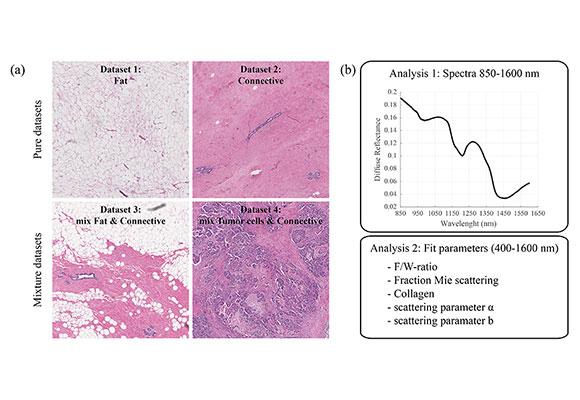The research, published in the SPIE Journal of Biomedical Optics, cites 92 studies that assert intra-surgery feasibility of diffuse reflectance spectroscopy

Credit: Lisanne L. de Boer; Esther Kho; Katarzyna Jó?wiak; Koen K. Van de Vijver; Marie-Jeanne T. F. D. Vrancken Peeters; Frederieke van Duijnhoven; Benno H. W. Hendriks; Henricus J. C. M….
BELLINGHAM, Washington, USA, and CARDIFF, UK – In an article published in the peer-reviewed SPIE publication Journal of Biomedical Optics (JBO), “Influence of neoadjuvant chemotherapy on diffuse reflectance spectra of tissue in breast surgery specimens,” research observed across 92 ex vivo breast specimens suggests that there is little to no impact on the optical signatures of breast tissue after neoadjuvant chemotherapy.
The results of the study, in which diffuse reflectance spectroscopy (DRS) measurements were performed on 92 ex vivo breast specimens from 92 patients treated with and without neoadjuvant chemotherapy, show that contrast between healthy tissue and tumor tissue is not altered due to neoadjuvant chemotherapy, suggesting that the same reflectance spectral signatures can be used for tumor margin guidance independent of the chemotherapy status of the patient.
Because healthy and tumor tissue can be readily discriminated, tumor-margin assessment by DRS — which can discriminate different tissue types based on optical characteristics — becomes a feasible consideration during breast-conserving surgery, even if the patient has received neoadjuvant chemotherapy prior to surgery, a procedure that has become commonplace. The ultimate goal of the intra-surgery application of DRS would allow the surgeon to assess the tissue while performing the resection of tumors to ensure that the resection margin is clear of tumor tissue.
According to JBO Editor-in-Chief, SPIE Fellow, and MacLean Professor of Engineering at the Thayer School of Engineering at Dartmouth College, New Hampshire, Brian W. Pogue, the paper and its findings are notable due to the large number of clinical samples analyzed, and the consequent relevance to assessing neoadjuvant chemotherapy changes. “While a significant amount of work has been done defining the spectral signatures of breast cancer tumors and showing that this can be used for guidance, this is one of the first attempts to examine tumors following neoadjuvant chemotherapy as well. The results show that the signatures do not appear to change and so the status of the patient would not confound spectral imaging to help define the lumpectomy margin.”
###
The article authors are Lisanne L. de Boer, Ester Kho, Marie-Jeanne T.F.D. Vrancken Peeters, and Frederieke van Duijnhoven of The Netherlands Cancer Institute (NCI), Department of Surgery, Amsterdam; Katarzyna Jó?wiak of NCI, Department of Epidemiology and Biostatistics, and Brandenburg Medical School Theodor Fontane, Institute of Biostatistics and Registry Research, Neuruppin, Germany; Koen K. Van de Vijver of NCI, Department of Pathology, and Ghent University Hospital, Department of Pathology, Ghent, Belgium; Benno H.W. Hendriks of Philips Research, Eindhoven, The Netherlands, and Delft University of Technology, Biomechanical Engineering Department, Delft, The Netherlands; Henricus J.C.M. Sterenborg, of NCI, Department of Surgery, and Amsterdam University Medical Center, Department of Biomedical Engineering and Physics; and Theo J.M. Ruers of NCI, Department of Surgery, and the University of Twente, TNW, Technical Medical Center, Drienerlolaan, Enschede, The Netherlands.
JBO, an open-access journal, is published in print and digitally by SPIE in the SPIE Digital Library, which contains more than 500,000 publications from SPIE journals, proceedings, and books, with approximately 18,000 new research papers added each year.
About SPIE
SPIE is the international society for optics and photonics, an educational not-for-profit organization founded in 1955 to advance light-based science, engineering, and technology. The Society serves more than 255,000 constituents from 183 countries, offering conferences and their published proceedings, continuing education, books, journals, and the SPIE Digital Library. In 2019, SPIE provided more than $5 million in community support including scholarships and awards, outreach and advocacy programs, travel grants, public policy, and educational resources. http://www.
Media Contact
Daneet Steffens
[email protected]
360-685-5478
Related Journal Article
http://dx.




